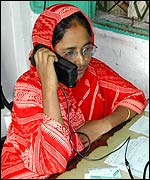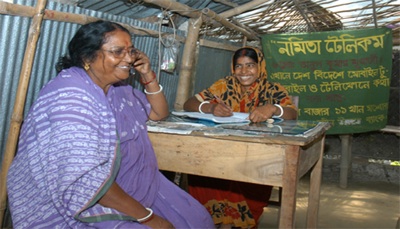Technologies That Connect
[Translations: Japanese]
Every month the Long Now foundation hosts its Seminar on Long-Term Thinking. I serve as a sort of co-host, winnowing questions from the audience to the speaker. This month’s speaker was Iqbal Quadir, formerly at Harvard and now at MIT. I met Iqbal at least 10 years ago and have been following his adventures in changing the world one cell phone at a time. Iqbal’s talk focused on how technology can alleviate poverty. Here’s my summary of the talk:
When Iqbal Quadir applied to US colleges from his home town in Bangladesh he was surprised to discover that not all American universities were found in Washington, DC. That’s how it was in Bangladesh, where everything of importance was centralized in the capital city, Dacca. He later realized that Bangladesh was not unique; in most developing countries, the infrastructure is concentrated in one or two cities, leaving the rural areas almost blank. As he acquired degrees and experience in finance, he realized that this centralization is not only a mark of poorer countries, it is probably a cause of their poverty.
Quadir presented this broad outline of development in order to give context for his belief that technology can alleviate poverty. He reminded us that 500 years ago, when the western countries were still “developing” their own societies, their political systems were no better, and often worse, than the instable corrupt regimes of many developing countries today. England had a series of kings who were impeached, arrested, ousted, or beheaded for their crimes. It was only after citizens were empowered by economic markets did the balance of power shift from the central king to decentralized citizens. All steps that devolve power away from a central authority — including laws, trade, and education — will raise democracy.
In Quadir’s view, it’s not that centralization per se creates poverty. Poverty is the natural beginning state of all societies, east or west. Rather, decentralization is the engine which removes poverty and brings wealth. To the degree that infrastructure, education, and trade can be decentralized, wealth will rise in proportion. To the degree that infrastructure, education and trade are centralized, poverty will remain.
Whereas many of us in the west, particularly the digital west, agree with this intuitively, we act contrary to this observation when we give large-scale aid to poor countries. As Quadir’s colleague Wiliam Easterly argues in his book “The Elusive Quest for Growth,” the billions and billions of dollars spent on aid for developing countries has not only *not* helped, it has set them back decades. Aid, as we know it, kills development. This harm occurs because almost all previous aid has funneled through a central government or semi-governmental organizations and that official route tightens centrality. Even if the governments were saintly, and they are definitely not, the scale of money flowing through these centralizing nodes prohibits the distribution of resources, infrastructure, trade, and education. The more aid that arrives, the less development can actually happen.
Technology is the escape from this quandary. Quadir came to see that “technologies that connect” could liberate productivity. He matched his experience in Bangladesh as a 13-year-old boy having to walk 10 kilometers to get medicine, only to find out the medicine man he sought was not home, and then walking back empty handed, having wasted a day — all because there was no connection between his home and the pharmacist. Many years later he wasted a day at work when there was no electricity to run phones or computers. Productity required connectivity. If connectivity could be decentralized then it would lead to increased wealth.
Quadir settled on the cell phone as a way to decentralized connectivity. In the early 1990s cell phones were big, dumb, and very expensive. Calls were $3 per minute. Only the rich could afford them. But he wanted the poorest people in the world to get them. How would this be possible?

First, he believed in Moore’s Law: that the phones would decrease in price and increase in power every year. That seemed inevitable to him. He said he could see “micro-chips marching toward the poor.” He was right about that. Second, he piggybacked his hopes on a remarkable invention of another Bangladeshi, Mohammad Yunus, who developed micro-financing (and later won a Nobel prize for this invention). In Yunus’ scheme a woman who owned virtually nothing could get a loan of $200 to purchase a cow. She would then sell the surplus milk of the cow to pay back the loan, earn both milk and an income for her family, and maybe buy another cow. Ordinarily, no bank would have lent her this trifling amount because she had no collateral, no education, and the costs of overseeing such a small loan with small gains, would have been prohibitive. Grameen Bank, Yunus’ creation, discovered that these illiterate peasants were actually more likely to repay these small loans, and were very happy to pay good interest rates, and so that in aggregate, these micro-loans were more profitable than loaning to large industrial players.

Quadir proceeded to ask, what if the women could rent a cell phone instead of a cow? Grameen Bank could make a micro-loan to the poor for the purchase a cell phone, which they then could sell/rent minutes to the rest of the village. The enterprising phone-renter would benefit and more importantly, the entire village would benefit from the connectivity. It did not really matter if the minutes were expensive, because when you have no connection, you are willing to pay dearly for it. Quadir started off his GrameenPhone with 5 cell towers, and eventually GrameenPhone erected 5,000 towers.
In 1993 when Quadir began, Bangladesh had one of the lowest penetrations of telephones on the planet — only one phone for every 500 people. GrameenPhone project unleashed 25 million phones. Today there are 100 times as many phones, or one per 5 people. Just as Quadir had envisioned, this decentralized connectivity has increased productivity. Without connectivity people waste a lot more time on economic errands. With cell connectivity farmers maximize their profits by getting real-time prices at distant markets; shepherds can call a vet, or order medicine. One study concluded that the total lifetime cost of an additional phone (including the cell tower and switching gear) was about $2,000, but that each phone enabled $50,000 of increased productivity. And surprisingly, the poorer the country to begin with, the greater the increase in wealth from connectivity.
A lot of myths cloud the good intentions of developmental aid, Quadir says. Myths such as: poor countries have no resources, or that the poor don’t have discretionary spending, or aren’t concerned with brands,or aren’t good credit risks, and so on. All these assumptions have been proven untrue over and over again, and especially so with GrameenPhone. The chief myth it dispelled was that government needs to subsidize technological development, when in fact there is good money to be made enabling the productivity of the poor. As Quadir says, “You don’t make money on the poor, but with the poor.” At dinner I asked Iqbal what he would have done differently with GrameenPhone. He replied, “Kept more shares.”
Quadir is now searching for other technologies to decentralize, and thereby become a tool to erase poverty. He is director of the Legatum Center for Development and Entrepreneurship at MIT, which has been funded with $50 million. He is investigating whether energy can also be dethroned from its current mode of extremely centralized generation. Only 10% of the electricity produced at its source remains at the end of the wires as they reach homes and factories. Perhaps there are ways to decentralize its generation, which would trigger connections at the local level, and in his scheme, elevate wealth and democracy. If it worked, decentralized energy might also work in rich countries, increasing wealth and democracy in our part of the world as well.
Throughout his talk, Quadir reiterated: “To raise productivity (and wealth), raise connectivity. It’s that simple.” Jaron Lanier suggests that connectivity might be one of the criteria we should use to evaluate whether a technology is desirable or not. We should ask ourselves, Jaron says, whether this technology increases connection among people, places and things, or decreases connections. Those technology that up connectivity will more likely do good. So far I have not thought of any counter examples.


